

Embletonia gracilis
Risbec, 1928
Order: NUDIBRANCHIA
Suborder: AEOLIDINA
Family: Embletoniidae
PHOTO
UPPER: AM C127466, 14 February 1981, under rock off manager's house, Christmas Is., Indian Ocean. Photo: John Hicks. LOWER: Radular ribbon. [see further photo] Photo: Geoff Avern.
Embletonia gracilis has a wide Indo-West Pacific distribution and although published accounts suggest a small animal less than 8mm long, it can grow to 20-30mm. This translucent white nudibranch is characterised by the single row of cerata down each side of the body, the tip of each ceras usually being divided into four, and containing nematocysts. Oral tentacles are replaced by flattened oral lobes flanking the mouth [they are often described as a bilobed oral veil]. Embletoniids are small and often very elongate.
Generally the family has been considered to be aeolidinan, probably closely related to the Tergipedidae. Most authors accept a single genus, Embletonia. Miller & Willan (1991) consider this small group of three, possibly four, species to be dendronotinans, giving four reasons for considering Embletonia to be dendronotinan: presence of dendronotinan oral veil; lack of oral tentacles; three-lobed oral gland; and lack of cnidosacs. Of these characters, the first two are really aspects of one feature. Either the head region is a dendronotinan oral veil, but lacking the characteristic ventral groove along each side, or it is a tergipedid head lacking oral tentacles. Miller & Willan fail to explain the lack of sheathed rhinophores which are characteristic of all other dendronotinans.
The three-lobed oral gland closely resembles the elaborate oral gland developed in the tergipedids, especially the coral-feeding genus Phestilla. Similarly the nature of the cnidosac is open to interpretation. Although Marcus & Marcus (1958) deny the presence of nematocysts in Embletonia, both Baba & Hamatani (1963) and W.B. Rudman (personal observation) have observed sacs containing nematocysts at the ceratal tips. In the European Embletonia pulchra, the tips of the cerata are rounded and, although a cnidosac is lacking, there are up to four terminal pads of nematocysts on each ceras. In the Indo-West Pacific species, the end of each ceras is divided twice, forming four knobs, each have a terminal sac containing nematocysts.
In all species the anus opens between the second and third cerata on the right and has been variously described as pleuroproct or acleioproct. The rhinophores are simple. Oral glands are present and the single median tooth in the uniscriate radula has a central pointed cusp flanked by a few denticles. The cutting edge of the jaw plates is denticulate. Most reports suggest they feed on hydroids.
References:
• Baba, K., 1959b. A new record of an interesting species, Embletonia gracile Risbec, from Japan (Nudibranchia -Eolidacea). Publications of the Seto Marine Biological Laboratory, 7(3): 335-336, Pl. 29.
• Baba, K. & Hamatani, I., 1963. Anatomy of Embletonia gracilis paucipapillata n. ssp. from Osaka Bay, Japan (Nudibranchia - Eolidoidea). Publications of the Seto Marine Biological Laboratory, 11(2): 399-402, Pl. 17.
• Gosliner, T.M., 1979. The systematics of the Aeolidiacea (Nudibranchia: Mollusca) of the Hawaiian Islands, with descriptions of two new species. Pacific Science, 33(1): 37-77.
• Gosliner, T.M. & Griffiths, R.J., 1981. Description and Revision of some South African aeolidacean Nudibranchia (Mollusca, Gastropoda). Annals of the South African Museum, 84(2): 105-150.
• Miller, M.C. & Willan, R.C., 1991. Redescription of Embletonia gracile Risbec, 1928 (Nudibranchia: Embletoniidae): Relocation to Suborder Dendronotacea with taxonomic and phylogenetic implications. Journal of Molluscan Studies, 58: 1-12, Figs 1-8.
• Risbec, J., 1928a. Contribution à l'étude des nudibranches Néo-Calédoniens. Faune des Colonies Françaises, 2: 1-328.
• Risbec, J., 1953. Mollusques nudibranches de la Nouvelle-Calédonie. Faune Union Française, 15 : 1-189.
• Rudman, W.B., 1998. Suborder Aeolidina. Pp 1011-1017. In: Beesley, P.L., Ross, G.J.B. & Wells, A. (eds). Mollusca: The Southern Synthesis. Fauna of Australia, Vol 5. CSIRO Publishing: Melbourne. Part B, 565-1234.
Rudman, W.B., 2002 (September 11) Embletonia gracilis Risbec, 1928. [In] Sea Slug Forum. Australian Museum, Sydney. Available from http://www.seaslugforum.net/find/emblgrac
Related messages
Embletonia gracilis from New Caledonia
February 14, 2006
From: Bill Rudman
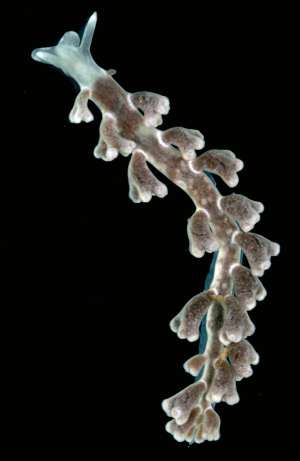
To accompany Yuji Fujie's recent message [#15804] here is a photo of a specimen of Embletonia gracilis from New Caledonia.
Locality: Grand Récif de Koumac, outer Barrier Reef, New Caledonia, 20°40'S, 164°11.2'E, 12m, Outside of reef, 7 October 1993, 30mm long alive, AM C200375. Photos: Bill Rudman
It shows how the cerata, and the four branches can extend and contract, quite considerably.
Best wishes
Bill Rudman
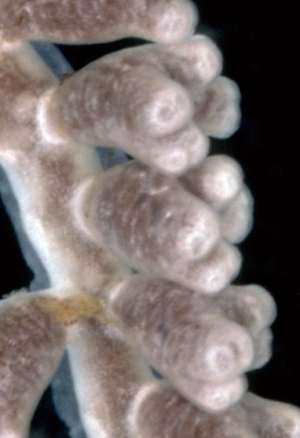
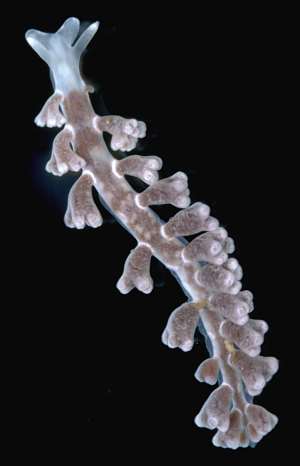
Very fat Embletonia gracilis ?
February 14, 2006
From: Yuji Fujie
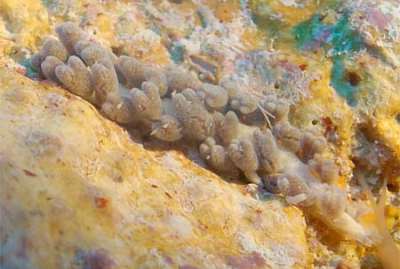
Hafa Adai Dr.Bill,
We've checked pictures of Embletonia gracilis but, I couldn't find any with cerata like these. Do you have picture of Embletonia gracilis like this in your stocks ?
Locality: Ice Cream, 17 m, Saipan, Northern Mariana Islands, Pacific Ocean, 08 February 2006, The lower side of rock. Length: 20 mm. Photographer: Yuji Fujie
I'd like to know actual name.
Si Yu'us Ma'ase !
Yuji Fujie
dswith@isletwind.com
Yuji Fujie, 2006 (Feb 14) Very fat Embletonia gracilis ?. [Message in] Sea Slug Forum. Australian Museum, Sydney. Available from http://www.seaslugforum.net/find/15804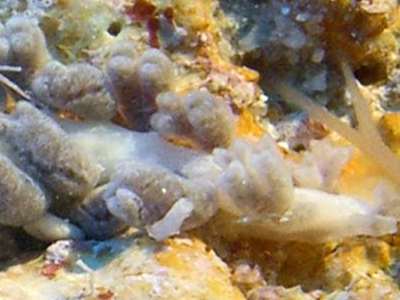
Dear Yuji,
I am pretty sure this is Embletonia gracilis. The photos I have used on the Fact Sheet show the way the tip of the cerata is split into four very well, but often the split is not so obvious. Perhaps when they are well fed, the digestive gland swells up and the split is not so clear. I will look out some other photos to show the variation
Best wishes,
Bill Rudman
Embletonia gracilis from Christmas Island
September 16, 2002
From: W.B. Rudman


To accompany Alicia's question about Embletonia I have prepared a page on Embletonia gracilis . Also, here is some information and photos on Embletonia gracilis from John Hicks' Christmas Island collections.
These specimens were 14, 25 & 30 mm long alive.
PHOTOS:
AM C127466, 14 February 1981, under rock off manager's house, Christmas Is., Indian Ocean. Photo: John Hicks
Best wishes,
Bill Rudman
billr@seaslugforum.net
Rudman, W.B. , 2002 (Sep 16) Embletonia gracilis from Christmas Island. [Message in] Sea Slug Forum. Australian Museum, Sydney. Available from http://www.seaslugforum.net/find/6587Question on the genus Embletonia
September 16, 2002
From: Alicia Hermosillo
Dear Dr. Rudman,
I was browsing through my books, again, to see if I caughtr a glimpse of any of my unidentified species ... I was looking at Hawaiian Nudibranchs (Bertsch & Johnson, 1981), a book out of print. On page 94 there is a picture of a very unusual Aeolid identified as Embletonia gracile. It is very long compared to the width... I have seen a few animals under rocks that look like that while surveying Bahia de Banderas. Very difficult to collect since they stick to the rock and you can not collect them without hurting them. I managed to collect one and take some tub shots but the animal contracted and the specimen in the pictures does not look like the animal under water at all.
I would like to know if that genus and species has changed or been synonymised with anything because I have not seen the genus mentioned in more recent literature or other pictures of them (again, I am not all that familiar with Indopacific or Hawaiian species). If you look at the picture of Pteraeolidia ianthina, page 115 in Coleman´s book that is the general shape of the animal, mine have been brown cerata on white body or all white, both times I have seen them there were about 10 or so together.
Any comments or ideas?
Thanks
Ali
gueri25@hotmail.com
Hermosillo, A., 2002 (Sep 16) Question on the genus Embletonia. [Message in] Sea Slug Forum. Australian Museum, Sydney. Available from http://www.seaslugforum.net/find/7921Dear Ali,
No Embletonia hasn't disappeared. It is one of many things I still have to add to the Forum so since you have brought the subject up I have prepared a page on Embletonia gracilis. It is intersting because there is some debate about whether it is belongs in the Aeolidina or the Dendronotina. As you will see in my discussion, I am in favour of the aeolid relationship.
The only sure way of knowing what you have is seeing a photo or an animal. Even if it not looking too natural in your 'tub shots' I should be able to get a clue to its identity. Things you could look for are the number of cerata in each row - in Embletonia the cerata are single and there are four bumps or tips to ech ceras.
Best wishes,
Bill Rudman
Radula of Embletonia gracilis
September 16, 2002
From: Bill Rudman


Here are some photos of the radular ribbon of Embletonia gracilis from Christmas Island, Indian Ocean. [AM C132427].Photos: Geoff Avern.
In Embletonia, oral glands are present and the single median tooth in the uniseriate radula has a central pointed cusp flanked by a few denticles. The cutting edge of the jaw plates is denticulate.
Best wishes,
Bill Rudman.
